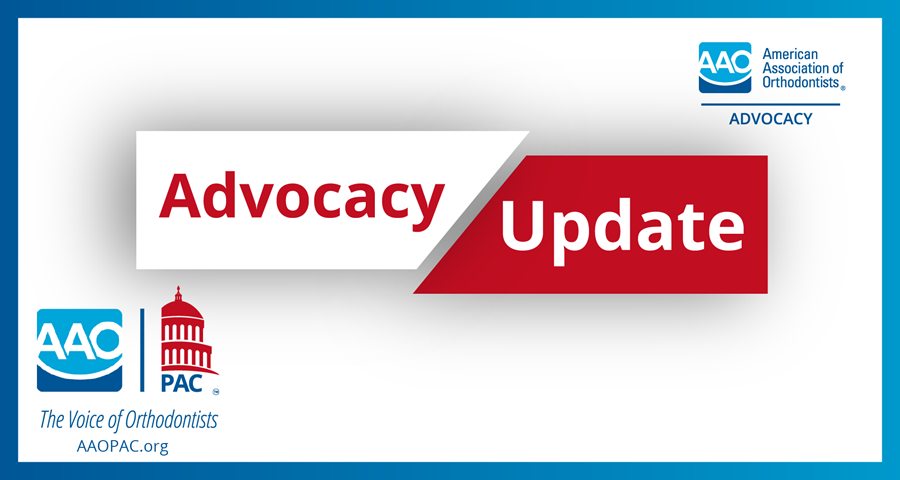Texas has joined a growing number of states taking decisive action to protect patient health and safety by requiring an in-person examination before orthodontic treatment can begin. With AAO Advocacy, Texas is now the eighth state to pass this type of legislation, joining Nevada, Florida, Illinois, Utah, Georgia, West Virginia, and Oklahoma.
The AAO partnered with the Texas Association of Orthodontists (TAO) and the Texas Dental Association (TDA) to support a clear aligner bill that includes a requirement that a licensed Texas dentist or orthodontist perform an in-person examination prior to initiating any orthodontic treatment.
HB4070 is a result of a multi-year effort to establish teledentistry parameters that are in the best interest of patient health and safety when utilizing clear aligners for orthodontic treatment via teledentistry.
AAO Advocacy in Action: A Process Retrospective/Timeline
(Progress in Texas Through Grassroots Engagement)
2020: Concerns grow over direct-to-consumer (DTC) orthodontic treatment models lacking in-person exams or proper supervision. AAO and TAO began closely monitoring and engaging with the Texas State Board of Dental Examiners (TSBDE) and Texas Legislature regarding teledentistry and patient safety concerns.
2021: Texas Legislature passes HB2056, legalizing teledentistry in Texas. Prior to 2021, the TAO successfully worked to ensure previous teledentistry legislation that did not have patient health and safety as the priority did not pass. HB2056 required the TSBDE to establish regulations governing teledentistry by rulemaking. AAO and TAO began actively engaging in the rulemaking process to advocate for strong safeguards for orthodontic patients.
2022: Texas State Board of Dental Examiners took final action to enact strong new teledentistry regulations for the State of Texas. During the rulemaking process, AAO and TAO submitted formal comments, letters, and testimony to the TSBDE, emphasizing the need for an in-person examination before beginning orthodontic treatment and other AAO teledentistry parameters that emphasize patient health and safety. Legislation was still needed, however, to uphold the Board’s rules and to require an in-person examination before orthodontic treatment.
2023: AAO, TAO, and TDA supported SB384, a bill similar to HB4070 that related to the sale, design, and manufacture of clear aligners used in orthodontic treatment via teledentistry. The bill passed the Texas Senate but did not receive a vote in the Texas House of Representatives.
2024: AAO, TAO, and TDA worked during the legislative interim to share evidence-based information with Texas lawmakers on the importance of an in-person examination prior to beginning orthodontic treatment. Resources from OrthoFacts.org were provided, including data that 77% of surveyed AAO members report seeing patients for retreatment who have used direct-to-consumer companies for treatment without an initial examination. AAO/TAO members stepped up and made personal contributions to Texas lawmakers, helping to build relationships important for our advocacy success.
2025: The bipartisan HB4070 is introduced in the Texas House by sponsors Representatives Ann Johnson, Trent Ashby, Drew Darby, Sam Harless, Denise Villalobos, and cosponsor Representative Josey Garcia.
After passage in the House Public Health committee, HB4070 is sent to the Texas Senate, where sponsor Senator Donna Campbell and cosponsor Senator Lois Kolkhorst carried it through the Senate Health and Human Services committee before passing the full Senate. The bill then went to Governor Greg Abbott for approval. The law will go into effect on September 1, 2025.
This patient health and safety success is a result of the combined efforts of AAO Advocacy and AAO/TAO member grassroots engagement combined with Texas state lawmakers seeing momentum from other states passing similar legislation to protect patients. Thanks to all members in Texas who engaged in grassroots actions to support the bill through the regulatory and legislative process over the last several years. Financial support from the AAO Component Legal Support Fund was also key as was the AAO’s work in partnership with the Texas Dental Association.
Special thanks to Lead Sponsors of the bill, Representatives Ann Johnson, Trent Ashby, Drew Darby, Sam Harless, Denise Villalobos, and cosponsor Representative Josey Garcia; and (sponsor) Senator Donna Campbell and cosponsor Senator Lois Kolkhorst.
Tremendous support came from AAO and TAO member grassroots volunteers, including Texas Association of Orthodontists President Ralph Brock; AAO trustee from the Southwestern Society of Orthodontists, Dr. Stephen Robirds; SWSO President, Dr. Matthew Ng; SWSO representative to the AAO Council on Government Advocacy, Dr. Chris Cramer; past SWSO Council on Government Advocacy Representative, Dr. Enrique Cruz; SWSO AAOPAC Director, Dr. Jeffrey Genecov; past SWSO AAOPAC Director and AAOPAC Chair, Dr. Clark Colville; and Texas AAO National Advocacy Network volunteers including AAOPAC Captain, Dr. Dean Jensen; Resident Captain, Dr. Tisha General; and Digital Advocacy Captain, Dr. Kristen Rouse.
Thanks are also due to Dr. Larry Tadlock for his testimony and conversations with Senator Kolkhorst; past AAO president, Dr. Gayle Glenn; the entire TAO Executive Board; and Carrie Simmons of Texas Lobby Partners (AAO’s Texas-state counsel).
Why this matters nationwide: State lawmakers often look at similar laws in other states when developing their own legislation. Texas’ passage of HB4070 strengthens national momentum around policies that put patient health and safety first and could inspire additional states to adopt similar protections.
Interested in helping advocate for similar legislation in your state? Get involved with the National Advocacy Network.
As the AAO continues advancing policy priorities in Washington, D.C. and across the states, consider supporting AAO Advocacy efforts. You can make your contribution celebrating AAO’s 125th anniversary at AAOPAC.org using the email address associated with your AAO membership.
Together, our grassroots network and AAOPAC supporters continue to make a lasting difference for AAO policy priorities nationwide.



